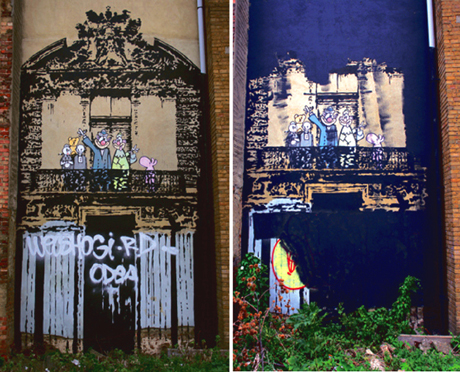Is it art? You decide

'Banksy' graffiti, Stoke Newington Church Street Photo: © 2009 The Hackney Citizen Ltd
THE destruction of a ‘Banksy‘ mural on private property has provoked criticism of a wider issue – Hackney Council’s refusal to distinguish between graffiti and public art.
The 20ft mural, now mostly covered in black paint, featured a spoof portrait of the Royal Family waving from a balcony. The design featured on Blur’s ‘Crazy People’ single in 2003 and it was worth an estimated £200,000.
The owner of the property, Sophie Attrill, 50, received no prior warning of the council’s intentions to remove the mural. Three statutory notices had been sent to a previous address due to incorrect details being held at the Land Registry office.
Having had no reply to the letters, the council exercised its power to act by default and sent in a graffiti removal team. Attrill – who was reportedly in tears – and an impromptu gathering of residents intervened to stop the removal team from completing their job.
A spokesperson said, “[Hackney] Council has a clear procedure in place, but it is unfortunate that in this case the details held by the Land Registry were incorrect.”
The Council’s website outlines its position on graffiti, stating: “Graffiti is illegal, anti-social and it degrades the local environment.”
No reference is made to the concept of public art, though the council stated that a private resident may apply for planning permission to prevent any alteration to their property.
Councillor Alan Laing, cabinet member for neighbourhoods, defended the council’s policy following the removal of the mural, saying, “Hackney Council’s position on graffiti is not to make a judgement call on whether graffiti is art or not – our task is to keep Hackney’s streets clean.”
This contrasts sharply with a new street art policy in Bristol, which seeks to”‘define and support the display of public art.”
Residents of Banksy’s reputed home turf will be able to cast an online vote as to whether a piece of public art should be removed or preserved, provided the owner of the property has raised no objections.
Photographs will be posted on Bristol Council’s website and notices may be placed next to the public artworks themselves.
Councillor Gary Hopkins, Bristol’s executive member for environment and community safety said, “We will use every means possible to tell people about the consultation.
When asked whether a public vote would only result in protecting Banksy’s creations, Mr Hopkins replied, “It doesn’t matter if it is famous or not – the question is whether the public want it to stay.”
Hackney Council however, regards the policy in Bristol as purely Banksy-orientated and it will not be adopted in Hackney. A spokesperson said, “Bristol’s consultation specifically looks at the removal of Banksy graffiti – it is his home city.”
Closer by, in Islington, there is no written policy on graffiti removal on private property, but a spokesperson from the council provided the following statement: “We work with landowners, such as Transport for London (TfL), Network Rail and registered social landlords to remove problem graffiti on private property. With the exception of obscene graffiti we cannot take it off private buildings without the owners’ consent.”
On council-owned buildings, Islington has adopted the following policy: “On our own property, we can take it off – or even repair it – in the case of Banksy. This would be a discretionary decision made by a senior officer.”
At the time of going to press, Hackney Council and Ms Attrill had not reached an agreement as to what next steps may be taken. Hackney Council said that it would continue with its programme of works, aiming to clean up the borough.
Let us know what you think via our online poll on public art. Treasure or trash? – you decide.
Previous story on public art here.
